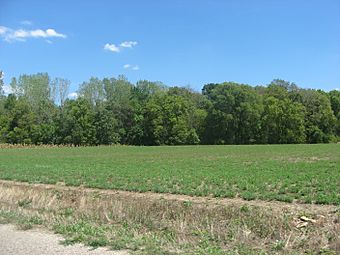Stoner Site facts for kids
Quick facts for kids |
|
|
Stoner Site
|
|

Overview of the site
|
|
| Location | Eastern side of 1550th Street between 1235th and 1300th Avenues |
|---|---|
| Nearest city | Robinson, Illinois |
| Area | 9 acres (3.6 ha) |
| NRHP reference No. | 78001143 |
| Added to NRHP | December 18, 1978 |
The Stoner Site is a very important archaeological site in Illinois, United States. It was found during the Great Depression. This site has given us many artifacts from an ancient village.
Archaeologists have studied the site. They found it is one of the most important places for learning about the Allison-Lamotte culture. After many years of research, the Stoner Site was named a historic site. This means it is a special place from the past.
Contents
Where is the Stoner Site?
The Stoner Site is in open fields. It is several miles from any towns. It sits near the Wabash River in Crawford County. A small stream called Sugar Creek flows nearby. The ground here is mostly clay. Some parts are marshy because of the stream.
The area around the site used to be a mix of open plains and forests. Today, it is mostly glaciated prairies. This type of land, near marshes, was common for villages of the ancient culture that lived here.
What Did They Find There?
The main thing found at the Stoner Site is a large, semicircular midden. A midden is like an ancient trash heap. It is believed to be where a prehistoric village once stood. This midden is about 450 feet wide and nearly 1 foot high. It contains many postholes, which are holes where wooden posts once stood. These posts likely held up houses.
The most important part of the midden is a large mound. It is about 33 meters by 24 meters wide and 1.5 meters high. This mound used to be taller, about 2.4 meters high. But farming over the years has made it smaller.
How Was It Explored?
The Illinois Archaeological Survey first recorded the Stoner Site in 1930. They did a quick survey, collecting things from the surface. For almost 30 years, not much else happened. Some people dug into the mound in the early 1950s, but it was not scientific.
Then, in the late 1950s, a local person named Denzil Stephens started working there. He was an amateur archaeologist. He did much more detailed work. He dug in the mound and the surrounding fields. He found the midden and the village site. He dug small test pits in many places. He found over 300 postholes. This showed him the full shape of one house and parts of 11 other buildings.
Stephens returned in the late 1960s. He dug in a different area. He found almost nothing there. This helped him figure out the exact edges of the ancient village.
What Artifacts Were Found?
Before Denzil Stephens, not many artifacts from Stoner were known. His early digs found new types of pottery. He also found new kinds of projectile points (like arrowheads).
As he kept digging, he found many cultural items. These included many projectile points from the Allison-Lamotte culture. He also found many stone tools. These were things like scrapers and celts. He found over 300 flint knives. Other finds included gorgets (decorative neck pieces). Some projectile points looked like those from the Merom Site in Indiana.
Clay artifacts were also found. The landowners found pieces of pipes near the mound. Stephens' digs found more pipe pieces. He also found one clay figurine. More than 5,000 potsherds (broken pottery pieces) have been recovered. Interestingly, there was almost no sign that the people ate shellfish. This is different from other nearby sites.
What We Learned About the Village
At first, Stephens thought the village was from a new, unknown culture. But his later work showed that the people were from the Middle Woodland period Allison-Lamotte culture. This culture lived from around the time of Christ until AD 400.
The way the postholes were arranged showed that the village had circular houses. These houses were usually about 22 feet across. They were built in a circle around a central open area, like a plaza. Other Allison-Lamotte sites also show similar village plans. Having a mound near the midden was also common for their villages.
Unlike some other groups, Allison-Lamotte mounds were not always for burying people. The landowners did not find any grave goods (items buried with the dead) in the mound. This is similar to what has been found at other mounds of this culture.
A few items from other cultures were found at Stoner. There were some things from the Havana Hopewell and the older Riverton culture. But these were very few compared to the Allison-Lamotte items. The pottery found at Stoner is very complete. It helps us understand the pottery of the Allison-Lamotte culture very well.
Why the Stoner Site is Important
The Stoner Site is very special because it is a well-preserved Allison-Lamotte village. It has a lot of evidence from that culture. This evidence is also "pure," meaning it is not mixed with many things from other cultures.
Because of this, the Illinois Archaeological Survey said it was the best example of the Allison-Lamotte culture in the state. Experts believed that future digs here could teach us a lot about daily life in this ancient culture. In the 1970s, people did not know much about how the Allison-Lamotte culture was different from other cultures nearby. The Stoner Site could help researchers learn more about these relationships.
In 1978, the Stoner Site was added to the National Register of Historic Places. This is because of its great archaeological potential. It is one of three important archaeological sites in Crawford County to get this honor. The others are the Riverton Site and the Swan Island Site.



